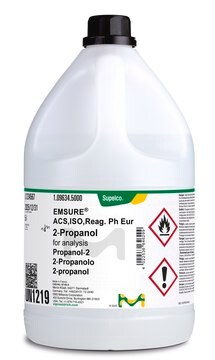1576708
USP
1,2-propanediol
United States Pharmacopeia (USP) Reference Standard
Synonyme(s) :
Propylène glycol
About This Item
Produits recommandés
Qualité
pharmaceutical primary standard
Densité de vapeur
2.62 (vs air)
Pression de vapeur
0.08 mmHg ( 20 °C)
Famille d'API
propylene glycol
Température d'inflammation spontanée
779 °F
Limite d'explosivité
12.5 %
Fabricant/nom de marque
USP
Indice de réfraction
n20/D 1.432 (lit.)
pb
187 °C (lit.)
Pf
−60 °C (lit.)
Densité
1.036 g/mL at 25 °C (lit.)
Application(s)
pharmaceutical (small molecule)
Format
neat
Chaîne SMILES
CC(O)CO
InChI
1S/C3H8O2/c1-3(5)2-4/h3-5H,2H2,1H3
Clé InChI
DNIAPMSPPWPWGF-UHFFFAOYSA-N
Vous recherchez des produits similaires ? Visite Guide de comparaison des produits
Description générale
Application
Also used to prepare standard stock, standard, sample, system suitability, and sensitivity solution for assay and impurity analysis according to the given below monographs of United States Pharmacopeia (USP):
- Propylene Glycol Dilaurate
- Phenytoin Sodium Injection
- Hydroxypropyl Betadex
- Butylene Glycol
Remarque sur l'analyse
Autres remarques
Produit(s) apparenté(s)
Code de la classe de stockage
10 - Combustible liquids
Classe de danger pour l'eau (WGK)
WGK 1
Point d'éclair (°F)
219.2 °F - closed cup
Point d'éclair (°C)
104 °C - closed cup
Faites votre choix parmi les versions les plus récentes :
Certificats d'analyse (COA)
It looks like we've run into a problem, but you can still download Certificates of Analysis from our Documents section.
Si vous avez besoin d'assistance, veuillez contacter Service Clients
Déjà en possession de ce produit ?
Retrouvez la documentation relative aux produits que vous avez récemment achetés dans la Bibliothèque de documents.
Les clients ont également consulté
Protocoles
99%; Glycerol, ≥99.5%; Tetraethylene glycol, 99%
Notre équipe de scientifiques dispose d'une expérience dans tous les secteurs de la recherche, notamment en sciences de la vie, science des matériaux, synthèse chimique, chromatographie, analyse et dans de nombreux autres domaines..
Contacter notre Service technique






